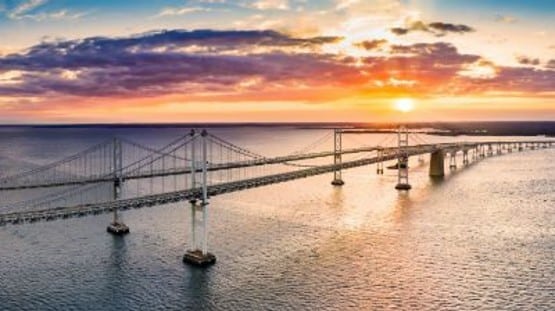
When a Florida manatee swims into the Chesapeake Bay, it makes waves.
Such was the case on Aug. 19, when one of the gentle giants was photographed munching on underwater grass in the St. Mary’s River in Maryland near where the Potomac River meets the Bay. Another followed on Aug. 27, when a group of paddleboarders spotted a manatee trapped in a pound net at the mouth of the Rappahannock River in Virginia. (It was freed, unhurt, by a marine patrolman within hours.)
Manatee sightings remain rare occurrences in Maryland and Virginia waters — rare enough that they generate a flurry of viral social media posts and news headlines. (Exhibit A: the manatee, nicknamed “Chessie,” that has captured the public’s imagination with its multiple visits to the Bay, beginning in the mid-1990s.)
Scientists don’t have enough data to say whether the whiskered marine mammals are visiting the region more frequently. But many believe it’s only a matter of time.
“You can mark my words and come back to me if I’m wrong. I think you’ll see more before you see fewer,” said Ruth Carmichael, a marine ecologist with the Dauphin Island Sea Lab in Alabama. She has been collecting reports of manatee observations across the southeastern U.S. for more than 15 years. “We’re seeing the same patterns in Mississippi and Texas and going up to North Carolina.”
Scientists don’t conduct formal surveys of manatees’ presence the Chesapeake region. But one measure suggests that an average of at least one per year ventures into the estuary.
Since the National Aquarium in Baltimore began keeping records in 1991, it has documented 39 manatee sightings in Maryland waters — either in the Chesapeake or the Atlantic Ocean. To qualify as an observation, the report must be accompanied by a photograph, said Kate Shaffer, who oversees the facility’s animal rescue program.
But there might be more in the future. Carmichael and other scientists point to a potential collision of three trends: a decades-long upswing in the species’ Atlantic population, a decline in water quality off Florida’s East Coast and warming waters tied to human-caused climate change.
The Florida manatee, also called a sea cow, was one of the first creatures to receive protection from the federal Endangered Species Act after it went into effect in 1973. Efforts to shield the manatees from boat collisions helped the population rebound from barely 1,000 individuals in the mid-1970s to more than 6,000 by 2017. That year, the U.S. Fish and Wildlife Service downlisted the species from endangered to threatened.
It’s only natural for manatees, especially males, to expand the boundaries of their range as their numbers increase, Carmichael said. Some have been tracked as far north as Cape Cod, MA, in recent years.
“Those animals have to go somewhere, and we know there’s the concept of carrying capacity,” she explained.
But that biological success story has hit a major snag. Since December 2020, about one-quarter of the species’ population has died during what federal wildlife officials have dubbed an “unusual mortality event” along the East Coast of Florida.
Worsening water quality appears to be at the center of the phenomenon, researchers say. Excessive nutrients spilling off lawns and farms are fueling the growth of a toxic form of algae, known as red tide, that is fatal to manatees. Such nutrients are also nourishing another type of algae bloom that has wiped out thousands of acres of seagrass, one of the manatee’s primary food sources. Many have starved.
Such pressures are likely to push manatees farther northward, research has suggested.
The Chesapeake Bay’s underwater grasses are proving to be an inviting refuge, said Jamie Testa, a dolphin researcher with the University of Maryland Center for Environmental Science and former marine mammal stranding coordinator for the Maryland Department of Natural Resources.
“We expect they find seagrass to eat in Chesapeake Bay and head back to the Southeast before water temperatures get too cold” around mid-October, she said.
Manatees begin showing signs of cold stress when water temperatures dip below around 68 degrees. So, with a typical thermometer reading of 48 degrees in February, the Chesapeake Bay is highly unlikely to become a year-round residence for sea cows, experts say.
“I don’t really see that yet,” said Dan Slone, a Florida-based manatee researcher for the U.S. Geological Survey. “Maybe in centuries.”
But warming water could widen the Bay’s visitation window, making sightings likelier both earlier and later in the season, Carmichael said.
For now, encounters in the Bay region still tend to induce astonishment. “I was surprised to see a manatee up here,” said Neil Gunter, the state marine police officer who responded to the Rappahannock report. “In fact, I didn’t believe it when the call came in.”
Their presence, though, is nothing new in the Chesapeake, Slone said. The first recorded manatee sighting in the region was in Virginia in 1676, he said.
“I just want to stress how unremarkable it is,” Slone said of this summer’s reports. “Can we say this is a new behavior that is changing what manatees are doing? I would say not in the absence of any new data.”
Officials and researchers urge the public to keep manatees at a distance and not to disturb them. They remain protected by the federal Marine Mammal Protection Act and the Endangered Species Act.
In Virginia, sightings can be reported to the Virginia Aquarium at 757-385-7575. In Maryland, reports of live manatees should go to the National Aquarium at 410-576-3880, while carcasses should be called in to the state Natural Resources Police at 410-260-8888.
Jeremy Cox is a Bay Journal staff writer based in Maryland. You can reach him at [email protected].









